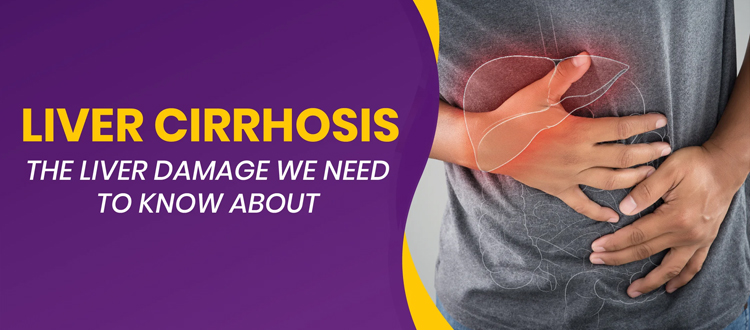The gradual and irreversible illness known as liver cirrhosis is typified by the liver tissue becoming scarred. This scarring hinders the liver’s ability to function properly, leading to a range of health complications. The liver plays a crucial role in various bodily functions, including detoxification, metabolism, and the production of proteins necessary for blood clotting. When cirrhosis occurs, these vital functions are compromised, posing a serious threat to overall health.
Causes of Liver Cirrhosis: –
The primary cause if liver cirrhosis is chronic liver disease, often resulting from long-term conditions such as chronic viral hepatitis B and C are common viral infections that can contribute to the development of cirrhosis over time. Excessive alcohol consumption, defined as heavy drinking over an extended period, is another leading cause. Additionally, obesity and metabolic syndrome can lead to NAFLD, a condition where fat accumulates in the liver cells, eventually progressing to cirrhosis. One of the distinctive features of cirrhosis is the formation of scar tissue, known as fibrosis.
Symptoms of Liver Cirrhosis: –
Symptoms of liver cirrhosis can vary, and they often become more apparent as the disease progresses. Common symptoms include fatigue, weakness, easy bruising, and jaundice (yellowing of the skin and eyes). Fluid retention may lead to swelling in the legs and abdomen. Portal hypertension can cause varices, enlarged veins that may bleed. Individual with cirrhosis may experience confusion, memory problems, and personality changed due to hepatic encephalopathy. As the liver’s ability to metabolized toxins can accumulate, affecting brain function. Other symptoms including weight loss, itching, and a tendency to bleed easily. Early detection and medical intervention are crucial for managing these symptoms and improving outcomes.
Diagnosis and Tests for Liver Cirrhosis: –
Diagnosing liver cirrhosis involves a combination of medical history, physical examination, and various testes. Blood tests can assess liver function, measure certain enzymes, and check for markers of liver damage. Imaging studies such as ultrasound, CT scans or MRI, help visualize the liver and detect abnormalities like scarring or nodules.
A liver biopsy, where a small tissue sample is taken for examination, may be performed to confirm cirrhosis and identify its cause. Additionally, transient elastography or fibro scan is a non- invasive test that measure liver stiffness, aiding in the assessment of fibrosis. These diagnostic tools collectively provide a comprehensive picture to guide appropriate medical management.
Stages of Liver Cirrhosis: –
Liver cirrhosis progresses through different stages, often categorized using scoring systems such as the Child-Pugh classification or the Model for End- Stage Liver Disease(MELD) score. These stages reflect the severity of liver damage and its impact on overall health.
- Compensated Cirrhosis: – At this early stage, the liver can still function reasonably well despite the presence of fibrosis (scarring). Many individuals may not experience noticeable symptoms.
- Decompensated Cirrhosis: – As cirrhosis advances, liver function declines, leading to complications. Symptoms such as fatigue, jaundice, and easy bruising become more evident.
- End- Stage Cirrhosis: – Characterized by severe liver damage, extensive scarring, and significant impairment of liver function. Individual may experience life threatening complications like portal hypertension, hepatic encephalopathy, and liver failure.
Treatment of Liver Cirrhosis: –
End stage “Liver cirrhosis treatment in India” is generally not curable, but its progression can be slowed or halted with appropriate medical management. “Liver cirrhosis treatment in New Delhi” involves managing symptoms, addressing underlying causes, and promoting liver regeneration.
Lifestyle modifications, such as alcohol cessation and a healthy diet, are crucial. Medications may target specific complications, like diuretics for fluid retention.
In advance cases, liver transplantation is considered. Emerging therapies, including stem cell treatment in New Delhi, shows promise in promoting liver regeneration and reducing fibrosis in case of acute or sub-acute stage of liver cirrhosis cases.
Stem Cell Therapy for Lever Cirrhosis: –
Stem cell therapy holds promise as a potential treatment for liver cirrhosis, a condition characterized by extensive liver scarring and impaired function. The liver’s regenerative capacity is limited, making it challenging for conventional treatments to restore organ function. Stem cells, with their unique ability to differentiate into various cell types, offer a novel approach to address this limitation.
In the context if liver cirrhosis, “mesenchymal stem cell (MSCs) for liver cirrhosis” have gained attention. These multipotent cells can be derived from various sources, including bone marrow, adipose tissue, and umbilical cord tissue. MSCs possess anti inflammatory and immunomodulatory properties, promoting tissue repair and regeneration which help to regenerate liver or hepatocyte cells via natural regenerating process and avoid further liver transplantation related surgeries.
When administered into the patient, MSCs migrate to the damaged liver tissue, where they exert their therapeutic effects. They can differentiate into hepatocyte-like cells, replacing damaged ones and contributing it functional recovery. Moreover, MSCs release paracrine factors that stimulate local cells proliferation, reduce inflammation, and inhibit fibrosis progression.
Clinical trials exploring the efficacy of the “Stem Cell Treatment for Liver Cirrhosis” have shown promising result, demonstrating improvement in liver function, reduction of fibrosis, enhanced overall patient wellbeing.
However, challenges such as optimal cell sources, dosage, delivery methods still need refinement.
Despite these advancements, stem cell therapy for liver cirrhosis in India is not yet widely adopted as a standard treatment due to the need for further research to establish its long- term safety and effectiveness. The field is evolving rapidly, and ongoing studies aim to address existing limitations, paving the way for a more comprehensive understanding of how stem cells can revolutionize the management of liver cirrhosis.
